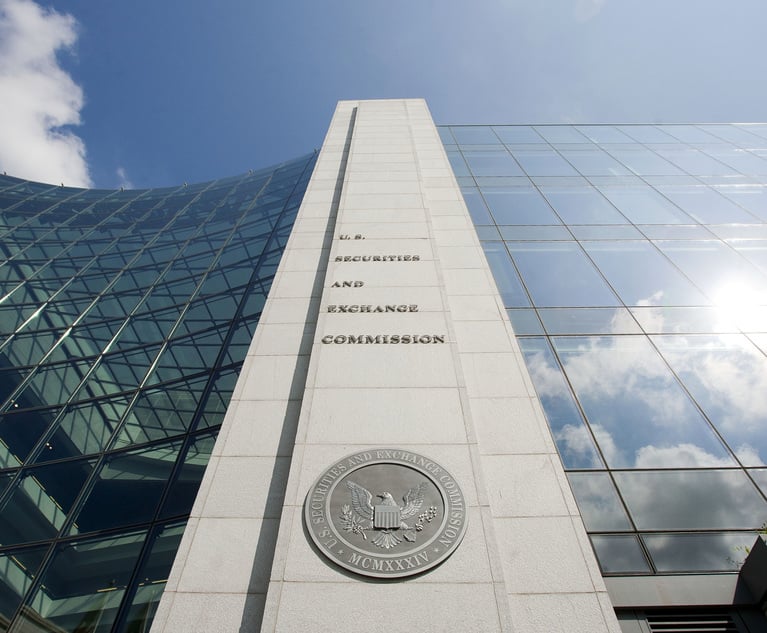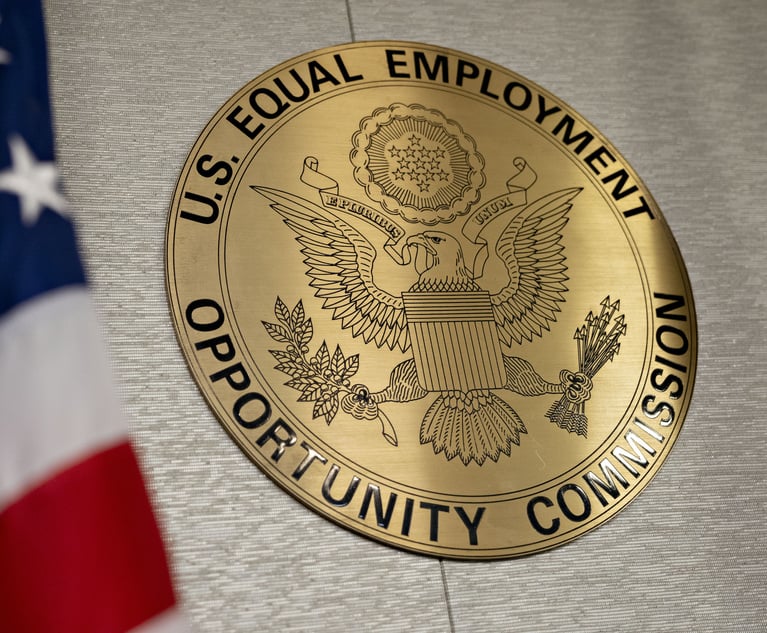Natural Selection
Supreme Court re-evaluates controversial diagnostic-process patents.
January 31, 2006 at 07:00 PM
7 minute read
When Laboratory Corporation of America asked the U.S. Supreme Court to hear its appeal, most IP experts thought it was little more than an act of desperation. The November 2004 certiorari petition asked the extremely busy High Court to review a technical issue that was of relatively little importance: Did a method patent on diagnosing vitamin deficiency specify the method in sufficient detail, or were the terms so vague that the patent had to be struck down?
However, the Court turned the case in a surprising direction. While pondering the petition, it invited the solicitor general in February 2005 to submit a brief addressing an issue that hadn't previously been raised in the case: “Is the patent [at issue] invalid because one cannot patent 'laws of nature, natural phenomena, and abstract ideas'?”
The solicitor general urged the Court in his August 2005 brief to decline certiorari. He argued that neither party had raised this patentability issue in the lower courts and beyond that, there was insufficient evidence in the record for the Court to rule on this issue.
The solicitor general's opinion carries a lot of weight with the Court. So it seemed as if his brief would put an end to LabCorp's hope for certiorari. But the Court ignored his arguments, and granted certiorari in October 2005.
“It is pretty surprising, particularly since the justices are focusing on an issue that didn't play any part in the Federal Circuit's decision,” says Rebecca Eisenberg, who teaches patent law at the University of Michigan Law School.
The parties are expected to argue their case before the Court in March. The outcome may redefine what types of inventions are patentable.
“The Court has realized that what has been issued as patents has gotten out of hand,” says Philip Swain, a partner in the Boston office of Foley Hoag. “The Court might go as far as knocking out business-method patents,” he adds.
Testing Claims
The case began with a patent owned by Competitive Technologies Inc., a Connecticut-based patent licensing company. Issued in 1990, the patent claims exclusive rights to a method of diagnosing whether a patient is suffering from a deficiency in vitamin B12 or folate. This deficiency can lead to vascular disease, cognitive dysfunction and cancer.
This patent is based on a chemical relationship between these two B vitamins and the amino acid homocysteine.
Because the vitamins help break down homocysteine, a B12 or folate deficiency creates elevated levels of homocysteine and its derivatives (known as total homocysteine) in the bloodstream. The patent basically asserts a method of testing total homocysteine levels to determine whether the patient is deficient in either vitamin B12 or folate.
Competitive licensed this patent to Metabolite Laboratories Inc., a small Denver company that sublicensed the patent to medical diagnostic companies. Then in 1999 Competitive and Metabolite jointly sued LabCorp, alleging the diagnostics company was infringing the patent by performing blood tests for total homocysteine levels.
LabCorp responded by arguing, among other things, that Competitive's patent failed to satisfy Section 112 of the Patent Act, which requires a patent to contain “a written description of the invention, and of the manner and process of making and using it, in ?? 1/2 full, clear, concise, and exact terms … ” According to LabCorp, the patent failed to detail how to carry out the blood test and then use the results to determine if there is a vitamin B deficiency.
A Colorado jury didn't buy it, and hit LabCorp with more than $2 million in damages. LabCorp appealed, but the Federal Circuit upheld the verdict.
LabCorp then asked the Supreme Court to reconsider the Section 112 argument, but the Court wasn't interested.
Instead, it granted certiorari in order to look at another issue–Section 101's standards for the scope of patentable subject matter.
“It appears they are trying to shoehorn [Section 101] into a Section 112 issue,” says Glenn Beaton, a partner at Gibson, Dunn & Crutcher who represents Metabolite.
Making A Statement
The Court seems concerned about one particular claim in the patent, which asserts exclusive rights to any method of using total homocysteine to diagnose vitamin B12 or folate deficiency. That claim reads: “A method for detecting a deficiency of cobalamin [also known as vitamin B12] or folate in warm-blooded animals comprising the steps of: [1] assaying a body fluid for an elevated level of total homocysteine; and [2] correlating an elevated level of total homocysteine in said body fluid with a deficiency of cobalamin or folate.”
The first part of this claim apparently asserts exclusive rights to any type of test for total homocysteine, even if the techniques for this test existed before the researchers filed the patent. More importantly, the second part of this test seems to assert exclusive rights to make the correlation between total homocysteine and vitamin deficiency.
“The correlation is a law of nature,” says James Foster, a shareholder with Wolf, Greenfield & Sacks. “The Supreme Court has repeatedly held that you cannot patent a law of nature.”
But if this claim was so obviously unpatentable, why didn't LabCorp initially attack the patent on these grounds? One reason is that this type of sweeping claim is now commonplace in patents.
“This is right in the mainstream of patents,” he says. “This isn't even a close call. And that's probably why the other side never pled this issue.”
LabCorp's lawyers declined to comment on this aspect of the case. However, if Beaton is right, the Court may use this case to further restrict patents on natural laws. “If this patent were to be invalidated, thousands of patents on diagnostic methods that have been issued in the past 20 years would be invalidated,” Beaton says.
An Unclear Future
Many experts believe the Court's ruling will have ramifications that will go far beyond diagnostic process patents.
“The Court wants to speak on the patentability of nontechnological subject matter, such as business-method patents,” Swain says. “This might be their way of taking up the State Street case.” (See Sidebar)
Other experts expect the justices won't reach quite so far.
“They [the justices] will say, at best, inventions that are too abstract can't be patented,” says John Thomas, who teaches patent law at Georgetown University. “They won't go after business-method patents.”
But he notes that such a Supreme Court ruling on abstractness could be used by lower courts and the Patent Office as a means of striking down business-method patents.
The most likely ruling, Thomas says, will be–based on Section 112–that the patent claim at issue was just too vague to explain how the invention should be practiced.
“That would be a pretty narrow holding,” Thomas says. “It wouldn't be a significant event.”
The significance of this case thus remains murky. “Though it is extremely rare for the Supreme Court to take a case unless they want to make a statement,” Foster says.
[SIDEBAR]
State Street's Legacy
Although more than seven years have passed since the Federal Circuit issued its ground-breaking ruling in State Street Bank & Trust Co. v. Signature Financial Group, the court's ruling remains controversial. The three-judge panel in that case held that methods for conducting business were patentable inventions under Section 101 of the Patent Act.
The court held that while mere abstract ideas or pure mathematical algorithms weren't patentable, they could be part of a patentable invention so long as the invention produces a “useful, concrete, and tangible result” (and satisfies the other usual patent standards, such as novelty).
In the wake of this ruling, the PTO has issued a wide variety of method patents. While many companies have lauded these patents, this sentiment is far from universal. Businesses and patent experts have excoriated many business-method patents, arguing that they are of dubious quality and should never have been issued.
This content has been archived. It is available through our partners, LexisNexis® and Bloomberg Law.
To view this content, please continue to their sites.
Not a Lexis Subscriber?
Subscribe Now
Not a Bloomberg Law Subscriber?
Subscribe Now
NOT FOR REPRINT
© 2025 ALM Global, LLC, All Rights Reserved. Request academic re-use from www.copyright.com. All other uses, submit a request to [email protected]. For more information visit Asset & Logo Licensing.
You Might Like
View All

Trending Stories
- 1'A Waste of Your Time': Practice Tips From Judges in the Oakland Federal Courthouse
- 2Judge Extends Tom Girardi's Time in Prison Medical Facility to Feb. 20
- 3Supreme Court Denies Trump's Request to Pause Pending Environmental Cases
- 4‘Blitzkrieg of Lawlessness’: Environmental Lawyers Decry EPA Spending Freeze
- 5Litera Acquires Workflow Management Provider Peppermint Technology
Who Got The Work
J. Brugh Lower of Gibbons has entered an appearance for industrial equipment supplier Devco Corporation in a pending trademark infringement lawsuit. The suit, accusing the defendant of selling knock-off Graco products, was filed Dec. 18 in New Jersey District Court by Rivkin Radler on behalf of Graco Inc. and Graco Minnesota. The case, assigned to U.S. District Judge Zahid N. Quraishi, is 3:24-cv-11294, Graco Inc. et al v. Devco Corporation.
Who Got The Work
Rebecca Maller-Stein and Kent A. Yalowitz of Arnold & Porter Kaye Scholer have entered their appearances for Hanaco Venture Capital and its executives, Lior Prosor and David Frankel, in a pending securities lawsuit. The action, filed on Dec. 24 in New York Southern District Court by Zell, Aron & Co. on behalf of Goldeneye Advisors, accuses the defendants of negligently and fraudulently managing the plaintiff's $1 million investment. The case, assigned to U.S. District Judge Vernon S. Broderick, is 1:24-cv-09918, Goldeneye Advisors, LLC v. Hanaco Venture Capital, Ltd. et al.
Who Got The Work
Attorneys from A&O Shearman has stepped in as defense counsel for Toronto-Dominion Bank and other defendants in a pending securities class action. The suit, filed Dec. 11 in New York Southern District Court by Bleichmar Fonti & Auld, accuses the defendants of concealing the bank's 'pervasive' deficiencies in regards to its compliance with the Bank Secrecy Act and the quality of its anti-money laundering controls. The case, assigned to U.S. District Judge Arun Subramanian, is 1:24-cv-09445, Gonzalez v. The Toronto-Dominion Bank et al.
Who Got The Work
Crown Castle International, a Pennsylvania company providing shared communications infrastructure, has turned to Luke D. Wolf of Gordon Rees Scully Mansukhani to fend off a pending breach-of-contract lawsuit. The court action, filed Nov. 25 in Michigan Eastern District Court by Hooper Hathaway PC on behalf of The Town Residences LLC, accuses Crown Castle of failing to transfer approximately $30,000 in utility payments from T-Mobile in breach of a roof-top lease and assignment agreement. The case, assigned to U.S. District Judge Susan K. Declercq, is 2:24-cv-13131, The Town Residences LLC v. T-Mobile US, Inc. et al.
Who Got The Work
Wilfred P. Coronato and Daniel M. Schwartz of McCarter & English have stepped in as defense counsel to Electrolux Home Products Inc. in a pending product liability lawsuit. The court action, filed Nov. 26 in New York Eastern District Court by Poulos Lopiccolo PC and Nagel Rice LLP on behalf of David Stern, alleges that the defendant's refrigerators’ drawers and shelving repeatedly break and fall apart within months after purchase. The case, assigned to U.S. District Judge Joan M. Azrack, is 2:24-cv-08204, Stern v. Electrolux Home Products, Inc.
Featured Firms
Law Offices of Gary Martin Hays & Associates, P.C.
(470) 294-1674
Law Offices of Mark E. Salomone
(857) 444-6468
Smith & Hassler
(713) 739-1250







